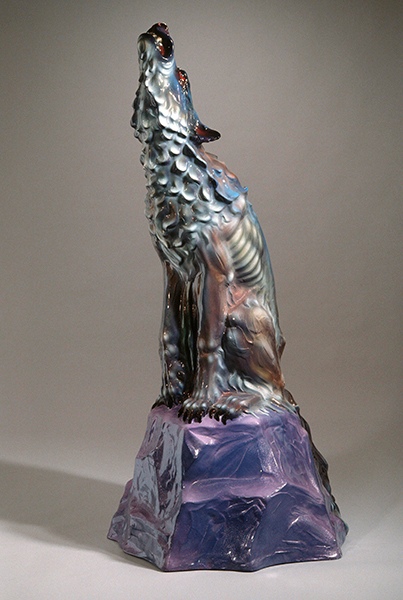Hispanic Heritage Month: Luis Jiménez
Although often associated with Pop Art because he plumbed myths, stereotypes, and mass media for subject matter, Mexican American artist Luis Jiménez approached his satire from a more critical, rather than ironic, angle. Anchored in the Southwest, he chronicled American and Hispanic cultures, how they merged, and often how they clashed. Jiménez’s contribution to the art of the time makes his work rise above the designation of merely Pop.
 |
| Luis Jiménez (1940–2006, U.S.), Howl, 1986. Fiberglass, acrylic urethane paint, 60" x 36" x 36" (152.4 x 91.4 x 91.4 cm). Spencer Museum of Art, University of Kansas, Lawrence. © 2021 Luis Jiménez/Artists Rights Society (ARS), New York. (SMA-80jzars) |
Jiménez used the ancient Roman She-Wolf of the Capitol (Capitoline She-Wolf) as a point of departure for Howl. It was also based on a mass-produced wooden tourist object in the U.S. Southwest of a coyote howling at the moon. This clichéd object was sold to tourists who considered it an "authentic" piece of Southwestern culture. From the single, flat piece of painted wood of the tourist piece, Jiménez enlarged the concept of the coyote to a monumental symbol that harkens back to ancient Mexican depictions of animals that acted as familiars to rulers and priests.
The coyote transcends a mere tourist object. For many Native American cultures, the coyote represents a trickster. For ancient Mexican cultures, the coyote was a symbol of military strength and cunning. Jiménez, who spent his life in the border town of El Paso, Texas, represents the coyote as a source of commonality between both sides of the border. He reclaims the subject from shallow, mass-produced painted wood in Southwest galleries, elevating it to a three-dimensional icon with an elegant dignity and strength.
Visits to his grandparents in Mexico City introduced Jiménez to the imagery of the early-1900s Mexican muralists. His grandfather was a glassblower, and his father was a sign-maker who had hopes of becoming a professional artist. From the age of six, Jiménez worked in the shop, becoming acquainted with fiberglass and the paints that could be used on it.
After graduating from the University of Texas in Austin (1964), Jiménez spent two years studying art at Ciudad Universitaria in Mexico City. He moved to New York in 1966, a time when Pop Art dominated the art world. Although interested in the idea of art works that appealed to everyday Americans, he sought a type of realism that introduced significant cultural content that made popular imagery relevant to Mexican Americans. He returned to El Paso in 1972, spending time there and at his studio in Hondo, New Mexico, for the remainder of his life.
Jiménez used classical art as a reference point for his works, but his interest is more in subject matter than formal and expressive qualities in his sculpture. By the time of his first one-person show in New York, he had introduced subjects in his sculpture that referenced aspects of Mexican American life and history. He focused on political and social conditions of Mexican Americans that, at the time, were controversial. His emphasis on his ethnic background made his sculpture more compelling than simple parodies of American commercialism.
Correlations to Davis programs: Explorations in Art 2E Grade 3: 5.1; Explorations in Art 2E Grade 5: 4.6; Explorations in Art 2E Grade 6: 2.6; Exploring Visual Design 4E: Chapter 6

Comments